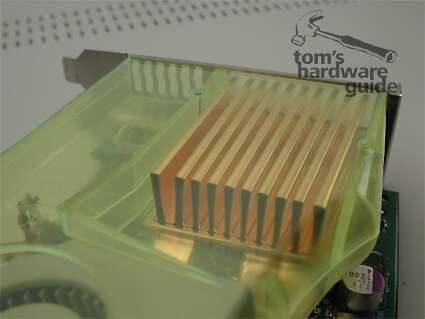NVIDIA GeForceFX: Brute Force Attack Against the King
The Cooler, Continued
When we pointed out the immense noise generated by the card, NVIDIA responded by assigning this to the prototype status of the card. In the final design, the noise level is supposed to be reduced considerably. In its current state, the noise produced by the card is really unbearable. However, the noise is due to the fan, which has a very high rotation speed, and it's difficult to imagine how the noise level could be reduced to a level that could be considered acceptable.
To give you an idea of how loud this test card is, we've recorded the noise with a microphone and made it available as an MP3 file. As a point of comparison, we've also recorded an ATI Radeon 9700 PRO at an identical recording level and microphone position. The CPU cooler we used here is an Alpha PAL 8045 Silent - the noise generated by its fan is negligible and plays no role in this recording.
This is what you hear in the MP3 file:
- geforcefx-boot-hq.mp3 - The GeForceFX booting up. The fan revs up and then reduces its rotation speed in 2D mode.
- geforcefx-3dmark-hq.mp3 - GeForceFX 3D Performance Mode. A 3D application starts up, and then we go back to the desktop (i.e., 3D Mark starts and ends). The card switches to 3D Performance Mode, and the fan increases its rotation speed. Afterwards, it slowly reduces speed when returning to 2D Desktop Mode.
- r9700-boot-hq.mp3 - Radeon 9700 booting up. The PC is booted. The recording level and the microphone position are the same.
Naturally, the noise level in this recording depends on the playback volume. A good approach for the correct sound volume is the beep of your PC case when it powers on (with an open case).
When you compare these recordings, it becomes clear why NVIDIA simply must continue to work on reducing the noise level, as they have promised. It's still a puzzle as to how this is going to happen. Even the noise volume in 2D Desktop Mode would be considered too loud.
Get Tom's Hardware's best news and in-depth reviews, straight to your inbox.
